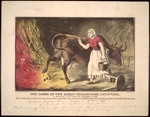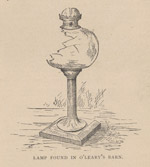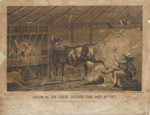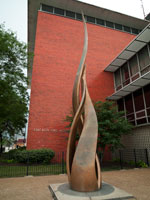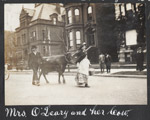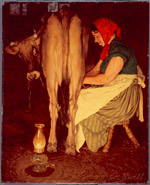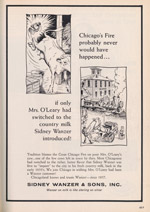The O'Leary Legend
Late one night, when we were all in bed,
Mrs. O'Leary lit a lantern in the shed.
Her cow kicked it over,
Then winked her eye and said,
"There'll be a hot time in the
old town tonight!"
Popular Song Lyric
Did Mrs. O'Leary's cow start the Great Chicago Fire?
It's possible. The conflagration almost surely began in the vicinity of the crowded barn, where Kate O'Leary kept the five cows she milked twice a day in order to help support the five O'Leary children. She also owned a horse that pulled the wagon, as well as a calf. She and her husband Patrick had just laid up plenty of coal, wood shavings, and hay for the winter--and to feed the flames when the barn took fire. There was a rumor that Kate admitted to different people right after the blaze began that she was in the barn when one of her cows kicked over a lantern. A few curiosity-seekers claimed to find the broken pieces of such a lantern while snooping behind her cottage, whose escape from destruction was one of the ironies of the disaster.
But there are plenty of reasons to think that Mrs. O'Leary and her benighted cow--named Daisy, Madeline, and Gwendolyn in assorted retellings--were innocent. Kate O'Leary offered sworn testimony that she was in bed when the fire started, and the official inquiry concluded that it found no proof of her guilt. Those who heard her "confess" presented conflicting versions of why she said she was in the barn. A person who years later claimed that as a boy he found the broken lamp under some floorboards and took it home never explained how, if the barn had floorboards, they made it through the inferno. As for the lamp itself, he said that he couldn't produce it because an Irish servant, as part of a cover-up, "borrowed" it and then disappeared. (The Chicago History Museum has in its collections a few cowbells that were also supposedly discovered on the site of the barn after the fire.)
On top of this, on the fortieth anniversary of the great conflagration a reporter named Michael Ahern, who was working for the Chicago Republican at the time of the fire, boasted in the Tribune that he and two now-deceased cronies made the whole thing up. The O'Learys, he reminded readers, lived in the rear part of the cottage, renting the front to a family named McLaughlin, who were hosting a party that evening. Ahern opined that one of the revelers went out to get milk and ended up burning Chicago down. To make the mystery murkier, the invention of the cow story has also been attributed to others, and after Ahern's revelation appeared a long-time colleague stated that he had ghost-written the Tribune story under Ahern's byline. As for Ahern himself, this other reporter confided, "The booze got him many years ago, and he has not been able to do any newspaper work."
Several additional theories surfaced at the time of the fire and since. Some boys were sneaking a smoke or gambling in the barn. Spontaneous combustion. A meteor split into pieces as it fell to earth October 8, setting off the simultaneous catastrophic fires in Chicago and Peshtigo, Wisconsin, plus a lesser conflagration in Michigan. Daisy acted alone. Richard F. Bales, writing in The Great Chicago Fire and the Myth of O'Leary's Cow, contends (as some others did in 1871 and in later years) that an O'Leary neighbor named Daniel Sullivan accidentally sparked the blaze. Bales bases his argument on an exhaustive review of property records and the post-fire inquiry.
It is highly unlikely that we will ever have definitive knowledge of the cause of the fire. In any case, the more intriguing issue is not the unresolvable one of whether the O'Leary legend has any truth to it, but why it has attracted so much continuing interest and why to the present day the story of Mrs. O'Leary's cow is above all others the one "fact" that almost everyone near and far recalls about the Great Chicago Fire.
The O'Leary story, true or not, has had such appeal because it offers a clear and specific cause for this enormous and complex event, an imaginative handle by which people can take hold of it. Regardless of the inconclusiveness of the official investigation, at the time of the fire the O'Leary story enabled people to blame someone in particular for what was a matter of collective responsibility and misfortune. In this respect it is noteworthy that the singling out of Catherine O'Leary found brief competition with a rumor that the fire was set by an unnamed member of a world-wide terrorist organization with direct ties to the 1871 Paris Commune. A local paper even published his "confession," and a poem that appeared in the New York Evening Post asked:
Did out of [Paris's] ashes arise
This bird with a flaming crest,
That over the ocean unhindered flies,
With a scourge for the Queen of the West?
But Mrs. O'Leary offered a far better scapegoat. While she herself may or may not have been at fault, what she represented was a more acceptable cause for the fire than the Communard. Unlike him, she was a familiar and recognizable type who could readily be made to stand for careless building, sloppy conduct, and a shiftless immigrant underclass. Blaming her adapted existing anti-Catholic, anti-immigrant, and possibly anti-female sentiments to the terrible calamity at hand in a way that was oddly comforting. As a poor clumsy Irishwoman and not a sworn enemy of the social order, she was a disempowered comic stereotype, and the damage she caused, massive as it was, could be reassuringly categorized as the result of accident, not conspiracy. Given that the catastrophe could not be undone, there was even something imaginatively satisfying in the tale that this epic fire had such a humble beginning.
The lasting nature of the O'Leary legend is attributable to the fact that she also was such a malleable figure, one who could be used to discover and express different and even contradictory meanings. From the outset, people were interested not in knowing the real Catherine O'Leary, but in turning her into a repository of their presuppositions. She was in her early forties at the time of the fire, sober and hard-working. In some popular anecdotes and illustrations she was characterized as an aged crone and a drunkard. The Chicago Times, while not naming her specifically nor accusing her of setting the fire deliberately, described Mrs. O'Leary as a welfare cheat who, "when cut off, vowed revenge." But as it became clear that the city had fully triumphed over catastrophe, she became increasingly quaint and benign. In 1881 the Chicago Historical Society installed a marble plaque marking the spot on the much more solid home that had been built on the O'Leary lot. The alley behind the house became a kind of sacred site for local residents, who protested when the city paved it two decades after the fire. And when Chicago constructed a new fire academy in the early 1960s, it selected as the location the block where the calamity began.
Perhaps the most remarkable and fanciful reworking of the O'Leary legend was the 1937 movie, In Old Chicago. Kate O'Leary (played by Alice Brady, who won the Academy Award for Best Supporting Actress) is aged a decade or two and divested of her husband, as she is transformed into the spirited widow Molly O'Leary, who runs a successful hand laundry that caters to Chicago's fancy set. To her dismay, her son Dion (Tyrone Power) becomes a rascally saloon owner, but his brother Jack (Don Ameche) is an idealistic lawyer who is elected mayor on a reform platform. The centerpiece of his program is to level the "the Patch" (evidently based on Conley's Patch), which is controlled by gamblers and political sharpers like his brother. Jack sacrifices his life for the city when, while he is trying to stop the fire, he is first shot by a corrupt political opponent and then crushed beneath a collapsing building.
Hearing this sad news from a morally awakened Dion as they find refuge in the lake, his mother proudly rededicates the family to the building of a new and better Chicago. The unsinkable Molly is reconciled to Jack's death by her faith in the future to come. For his part, Dion exultantly declares, "Nothing can lick Chicago." In this narrative with plot conventions shared by a long list of disaster stories (including Roe's Barriers Burned Away and MGM's 1936 disaster epic, San Francisco, which stars Clark Gable, Jeanette MacDonald, and Spencer Tracy), Hollywood turned once-despised immigrants like the O'Learys into upwardly mobile champions of the Chicago booster dream. One glancing coincidence between actual events and In Old Chicago is that the Patrick and Catherine O'Leary did have a son named Jim, who well after the fire was a politically connected saloon keeper in the stockyards district.
In Old Chicago does pin the fire's origin on Daisy, who kicks the lamp over when no one is looking. But this is almost incidental to the main plot, and there is no particular blame assigned to her or her owner. By this time the legend was a charming mainstay of American folklore, the subject of a Norman Rockwell painting. On the anniversary of the fire, local parades, commemorations, and promotions would feature a woman dressed up as Mrs. O'Leary, leading a cow. The winner of the National Trophy in the 1960 Tournament of Roses Parade, whose grand marshal that year was Vice President Richard Nixon, was the City of Chicago float, on which was Mrs. O'Leary's barn, complete with a lantern, simulated fire, genuine smoke, and a carnation-and-chrysanthemum cow. The theme of the parade was "Tall Tales and True."
Kate O'Leary, unfortunately, never got to enjoy any of this. She bemoaned her own losses by the fire, which included all the animals in the barn except the calf, but otherwise she tried to avoid the unwanted attention, including offers from promoters who promised her money for public appearances. She and her family lived in a series of homes around 50th and Halsted, where journalists would seek her out for interviews in early October. She would ignore them or chase them away, and they in turn would make up stories that revived the old stereotypes about the unwashed immigrant poor. In 1886, for example, a Daily News reporter whom she supposedly rebuffed described her home as follows: "The house has no front door, in lieu of glass clothing is stuffed into two or three windows, and long before a stranger reaches the place the pungent odor of distillery swill and the effluvium of cows proclaim that old habits are strong with Mrs. O'Leary and that she is still in the milk business." Patrick O'Leary died in September of 1894, and Catherine passed away the following Fourth of July.

